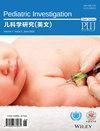Diagnose and treatment for Type D congenital esophageal atresia with tracheoesophageal fistula
IF 2
4区 医学
Q2 PEDIATRICS
引用次数: 0
Abstract
Type D esophageal atresia (EA) with tracheoesophageal fistula (TEF) is characterized by EA with both proximal and distal TEFs. It is a rare congenital anomaly with a very low incidence.To investigate diagnostic and treatment strategies for this rare condition.We retrospectively reviewed the clinicopathological features of patients with EA/TEF treated at our institution between January 2007 and September 2021.Among 386 patients with EA/TEF, 14 (3.6%) had type D EA/TEF. Only two patients were diagnosed with proximal TEF preoperatively. Seven patients were diagnosed intraoperatively. Five patients were missed for diagnosis during the initial surgery but was later confirmed by bronchoscopy. During the neonatal period, seven patients underwent a one‐stage repair of proximal and distal TEF via thoracoscopy or thoracotomy. Due to missed diagnosis and other reasons, the other 7 patients underwent two‐stage surgery for repair of the proximal TEF, including cervical incision and thoracoscopy. Ten of the 14 patients experienced postoperative complications including anastomotic leakage, pneumothorax, esophageal stricture, and recurrence. Patients who underwent one‐stage repair of distal and proximal TEF during the neonatal period showed a higher incidence of anastomotic leak (4/7). In contrast, only one of seven patients with two‐stage repair of the proximal TEF developed an anastomotic leak.Type D EA/TEF is a rare condition, and proximal TEFs are easily missed. Bronchoscopy may aim to diagnose and determine the correct surgical approach. A cervical approach may be more suitable for repairing the proximal TEF.D 型先天性食管闭锁伴气管食管瘘的诊断和治疗
D型食管闭锁(EA)伴气管食管瘘(TEF)的特点是EA伴有近端和远端TEF。我们回顾性分析了2007年1月至2021年9月期间在我院接受治疗的EA/TEF患者的临床病理特征。在386例EA/TEF患者中,14例(3.6%)为D型EA/TEF。只有两名患者在术前被诊断为近端 TEF。七名患者在术中确诊。有 5 名患者在初次手术中漏诊,但后来通过支气管镜检查确诊。在新生儿期,7 名患者通过胸腔镜或开胸手术对 TEF 近端和远端进行了一期修复。由于漏诊和其他原因,另外 7 名患者接受了两阶段的 TEF 近端修复手术,包括颈部切开术和胸腔镜手术。14 名患者中有 10 名出现了术后并发症,包括吻合口漏、气胸、食管狭窄和复发。在新生儿期接受 TEF 远端和近端一期修复的患者吻合口漏的发生率较高(4/7)。相比之下,在对近端 TEF 进行两阶段修复的七名患者中,只有一人出现吻合口漏。支气管镜检查可用于诊断和确定正确的手术方法。颈部入路可能更适合修复近端 TEF。
本文章由计算机程序翻译,如有差异,请以英文原文为准。
求助全文
约1分钟内获得全文
求助全文
来源期刊

Pediatric Investigation
Medicine-Pediatrics, Perinatology and Child Health
CiteScore
3.30
自引率
0.00%
发文量
176
审稿时长
12 weeks
 求助内容:
求助内容: 应助结果提醒方式:
应助结果提醒方式:


